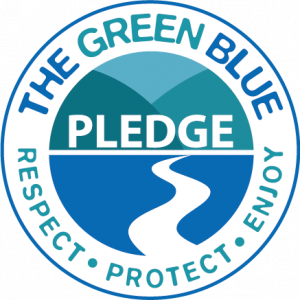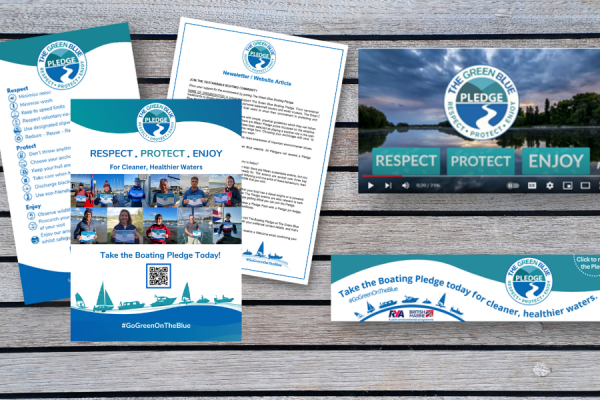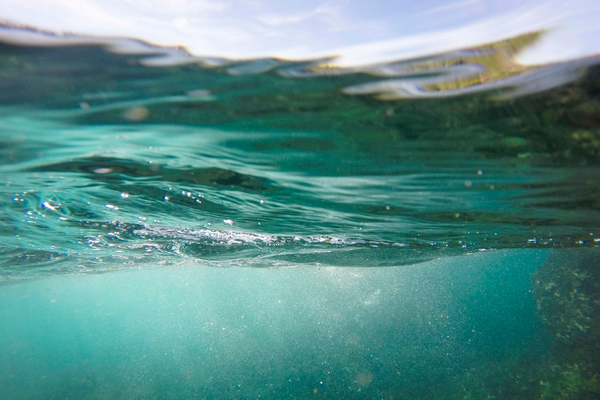The Boating Pledge

Join our Sustainable Boating Community!
“Never doubt that a small group of thoughtful committed individuals can change the world.
In fact, it’s the only thing that ever has”
Quoted from Margaret Mead

The Boating Pledge is for anyone who enjoys getting out on the water in a more environmentally sustainable way and wants to pledge to Respect, Protect, and Enjoy our inland and marine waters, wildlife and habitats
RESPECT

Minimise noise
Noise tends to travel further distances across open water. By keeping noise level low, especially when you see wildlife, you will help to minimise any disturbance that could impact on their resting, breeding and feeding habits.

Minimise wash
Wash and speed are closely connected. The wash from a boat can cause damage, often to unique and sensitive habitats, by uprooting aquatic vegetation, that overtime causes erosion to banks (a key cause of habitat loss). Wash can also cause damage to other boats moored up, and even loosen their moorings; plus, it impacts the experience on the water for other recreational users.

Keep to speed limits
Keeping to the speed limits helps protect shoreline habitats and wildlife through minimising wash, noise and risk of impact. Slower speeds also help to maintain engine efficiency and reduce fuel use.
Speed limits are also in place to protect other boat users, prevent potential injuries and collisions as well as prevent damage to other vessels, equipment and infrastructure.

Respect voluntary no-anchor and no-access zones
There is a reason why these are in place. Often, it’s to protect a sensitive seabed habitat or an area protected due to its conversation status. Avoiding these areas provides time and space for the plants and animals to establish or recover, creating a biodiverse habitat. They may be in place for safety or navigational reasons too.
For further information can be found on our Anchoring and Mooring with Care webpage.

Use designated slipways
By using slipways to land and launch your vessel or craft, will help to avoid the hull, equipment, your feet and trailer wheels from coming into direct contact with sensitive habitats e.g. seagrass or reed beds, that exist in shallow waters.

Reduce – Reuse – Repair – Recycle
Waste and over-consumption is a global issue worsening several environmental and societal issues. Where you can, try to follow the waste hierarchy: reduce, reuse, repair and recycle. This helps prevent waste and the associated pollution as well as saving you money.
More guidance: Waste & Recycling
PROTECT

Don’t throw anything overboard
Anything you throw overboard can have an impact on water quality, wildlife other water users. Even an orange peel can take around 2 years to degrade in the water, and the milky remains from a cup of coffee can lead to the build up of bacteria in the water. Keep a recycling and general waste bin onboard and always secure items so they don’t accidently fall or get blown into the water.
More guidance: Waste & Recycling

Choose your anchorage with care
Avoid damaging sensitive seabed habitats by choosing your anchoring location wisely, using available moorings whenever possible, choosing the correct anchor for the type of seabed to prevent drag, and using the correct length of chain to avoid excessive erosion on the seabed.
Find out more: Anchoring and Mooring with Care

Keep your hull and equipment clean
This action is vital to prevent the spread of invasive non-native species, which can cause harm to the environment, the economy, our health, and disrupt recreational activities.
A clean hull also means a smoother journey, reducing the energy required from the engine and maximising speed by reducing the friction. It also helps to maintain the condition of your boat.
Find out more: Invasive Species Prevention

Take care when handling fuels, oil and paints
These substances are hazardous materials, so should be stored, used, and disposed of with care. Any spills or leaks can pollute waterways causing harm to wildlife and habitats. One litre of oil can pollute one million litres of water.
Find out more:

Discharge blackwater responsibly
Black and grey water discharge cause water pollution by adding harmful bacteria and other toxic substances into the water, causing harm to wildlife and habitats, as well as being highly unpleasant for other people using the water.
Use shoreside facilities and consider installing a holding tank, if you do not have one already, to allow you to hold onto your black water until you can use a pump out facility or discharge away from the shoreline, bathing beaches and environmentally sensitive areas.
Find out more:

Use eco-friendly cleaning products
Anything used to clean your boat and equipment, or onboard, can leech into our waterways causing pollution. Think about what ingredients are in any cleaning products used. Choose eco-friendly products avoiding chlorine, bleach, and phosphates.
Find out more:
ENJOY

Observe wildlife from a distance
One of the joys of being out on the water is seeing wildlife in its natural environment. To minimise disturbance and risk of collisions with wildlife it is best to keep a distance of 100 metres and maintain a steady course. If wildlife approaches you, slow down and keep on course and allow the wildlife to decide when to leave, never follow wildlife.
Deliberate disturbance through chasing, noise, wake and erratic movement is an offence under UK legislation for many of the protected native species.
Find out more:

Research your destination to get the most out of your visit
If visiting somewhere new there are likely some hidden gems in the local area to explore. Plan your route taking proper account of weather and tides (if sailing in coastal waters). Plan your clothing choices for bad weather – this is the UK after all! And check out SafeTrx, the free RYA app, to let people know of your plans and your safe arrival.

Enjoy our amazing inland and marine waters whilst safeguarding wildlife and habitats
We are lucky to be surrounded by beautiful coasts, rivers, canals, and lakes with an array of amazing wildlife and habitats.
It is important for us to take care of our boating environment. By following the environmental best practice within this Pledge and beyond, you will be joining a growing community of boat users helping to safeguard the boating environment we rely on for our enjoyment, wellbeing and livelihoods.


